Scuffing is a severe form of adhesive wear, where surfaces in contact experience frictional forces that lead to material transfer and damage. It often results in visible marks or surface deformation. It occurs when the roughness peaks of surfaces in contact experience high flash temperatures and weld. These welds are easily broken by the relative motion, leading to deformation and material removal.
What is FZG
The FZG gear test rig, developed by the the Gear Research Center (FZG) at the Technical University of Munich, simulates operational conditions to assess lubricant and gear material performance. This rig features a gear pair (pinion and gear) mounted and meshed within a test chamber, representing real-world gear types and sizes. A lubrication system supplies the gears with test lubricant to mimic operational conditions. The gear pair undergoes rotation and loading cycles to replicate dynamic operational stresses and sliding velocities. Inspections after the test or between test steps identify wear, pitting, scoring, or damage, guiding lubricant selection and gear design optimization for industrial machinery and automotive applications.
Ducom Twin Disk Tribometer
The Ducom Twin Disk ribometer is an advanced testing platform designed for evaluating materials and lubricants used in rolling element bearings, gears, and rail-wheel applications. This tribometer features independently driven twin disks that enable rolling-sliding contact with a slide-to-roll and slip ratio ranging from 0 to 200% and from 0 to 100%, respectively. Capable of applying high loads up to 8 kN and achieving contact pressures exceeding 4 GPa between steel surfaces, the Twin Disk Tribometer offers versatile testing configurations, including roller on roller, block on roller, pin on roller, and ball on roller setups. Each spindle is driven by a variable-speed motor, and the tribometer includes automated loading units, friction torque sensors, and linear wear sensors to monitor performance metrics. The system allows for controlled experiments under lubricated or dry conditions with temperature control up to 120°C. The Twin Disk Tribometer serves as a reliable precursor to FZG tests, providing critical insights into material behavior and lubricant performance under extreme contact conditions.
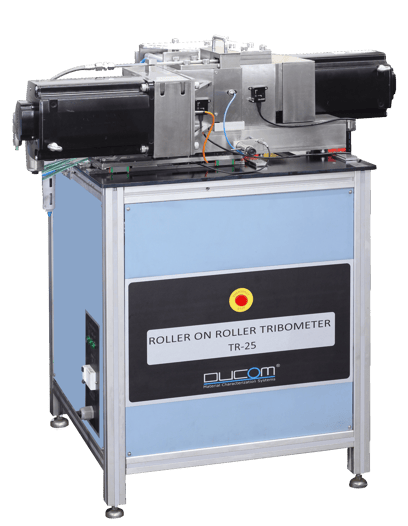
Frontal view of Ducom Twin Disk Tribometer .
Comparison between FZG and Twin Disk
Scuffing Capabilities
The FZG test method, designed for scuffing tests following step load increase standards such as ASTM D5182 or ISO 14635, specializes in evaluating a lubricant's ability to withstand extreme conditions leading up to scuffing. In contrast, the Twin Disk tribometer offers a more comprehensive simulation of real-world conditions by replicating specific contact scenarios with the same steel-on-steel line contact at varying slip ratios. The Twin Disk tribometer can mimic increasing contact pressures under load until scuffing occurs, providing insights into material and lubricant performance in rolling element bearings, gears, and rail-wheel applications. Unlike FZG, which focuses primarily on scuffing tests within specific load protocols, Twin Disk's flexibility allows for a broader range of tribological simulations, making it a versatile tool for studying complex interactions between surfaces and lubricants under variable conditions, ultimately contributing to enhanced understanding and optimization of mechanical systems.

Evolution of friction force and vibration (top), and evolution of the scoring on the test roller during a Twin Disk FZG-like test.
Extreme Pressure
FZG and Twin Disk showcase distinct capabilities related to contact pressures. FZG is limited to achieving contact pressures below 3 GPa, which is suitable for standard scuffing tests as per ASTM and ISO protocols. In contrast, the Twin Disk tribometer excels in surpassing this threshold, capable of reaching contact pressures exceeding 4 GPa while maintaining a steel-on-steel line contact configuration. Furthermore, by exchanging one of the rollers for a non-flat sample (e.g. ball, cylinder), the Twin Disk tribometer can achieve even higher maximum contact pressures. This capability allows for more extensive testing scenarios, particularly relevant for applications involving extreme load conditions such as rolling element bearings and high-pressure gear systems. The Twin Disk's versatility in replicating different contact configurations and achieving higher contact pressures makes it a valuable tool for studying materials and lubricants under realistic operating conditions, offering insights that go beyond the capabilities of traditional FZG testing methods.
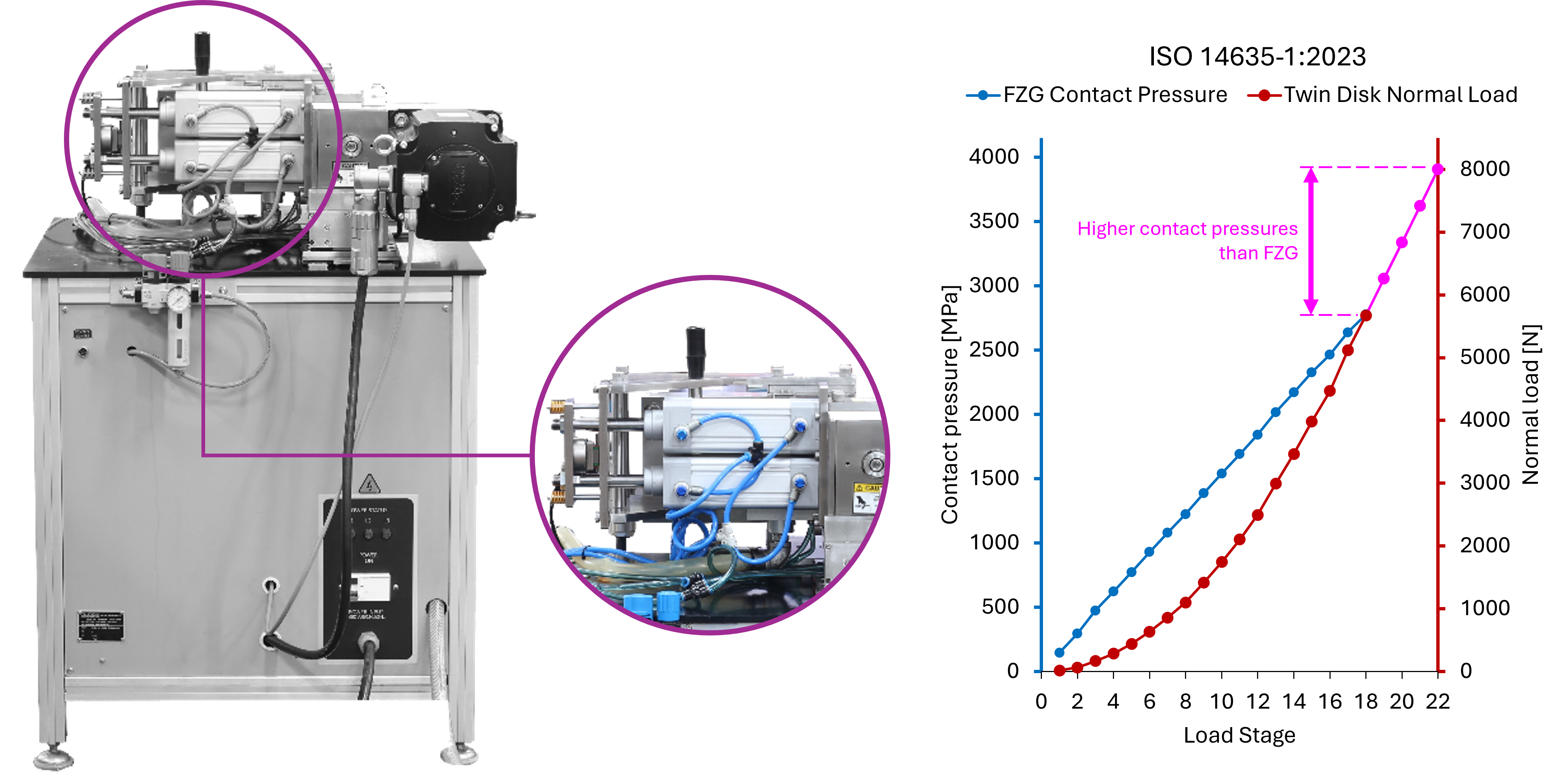
Highlight of the loading system that allows Twin Disk to achieve loads up to 5 kN (8 kN with the High Load option), achieving contact pressure beyond the requirement of common FZG standard test protocols.
Sample Manufacturing
When comparing FZG and Twin Disk in terms of manufacturing samples, notable differences arise in their sample mounting capabilities. FZG is primarily limited to mounting gear wheels and pinions, which can be challenging to manufacture due to complex shapes and to coating. In contrast, the Twin Disk tribometer utilizes rollers as specimens, offering several advantages. Rollers are relatively easy to manufacture, they can be carved from relevant bulk material (e.g. rail materials) and are easy to coating or reworking to achieve specific surface finishes. Moreover, the Twin Disk system provides enhanced versatility by accommodating various specimen sizes, including balls, pins, cylinders, and blocks, for testing against the roller. This flexibility allows researchers to explore a wider range of material interactions and lubricant performances under different contact configurations, making the Twin Disk tribometer a more adaptable and accessible tool for studying tribological behavior compared to the more specialized FZG method.
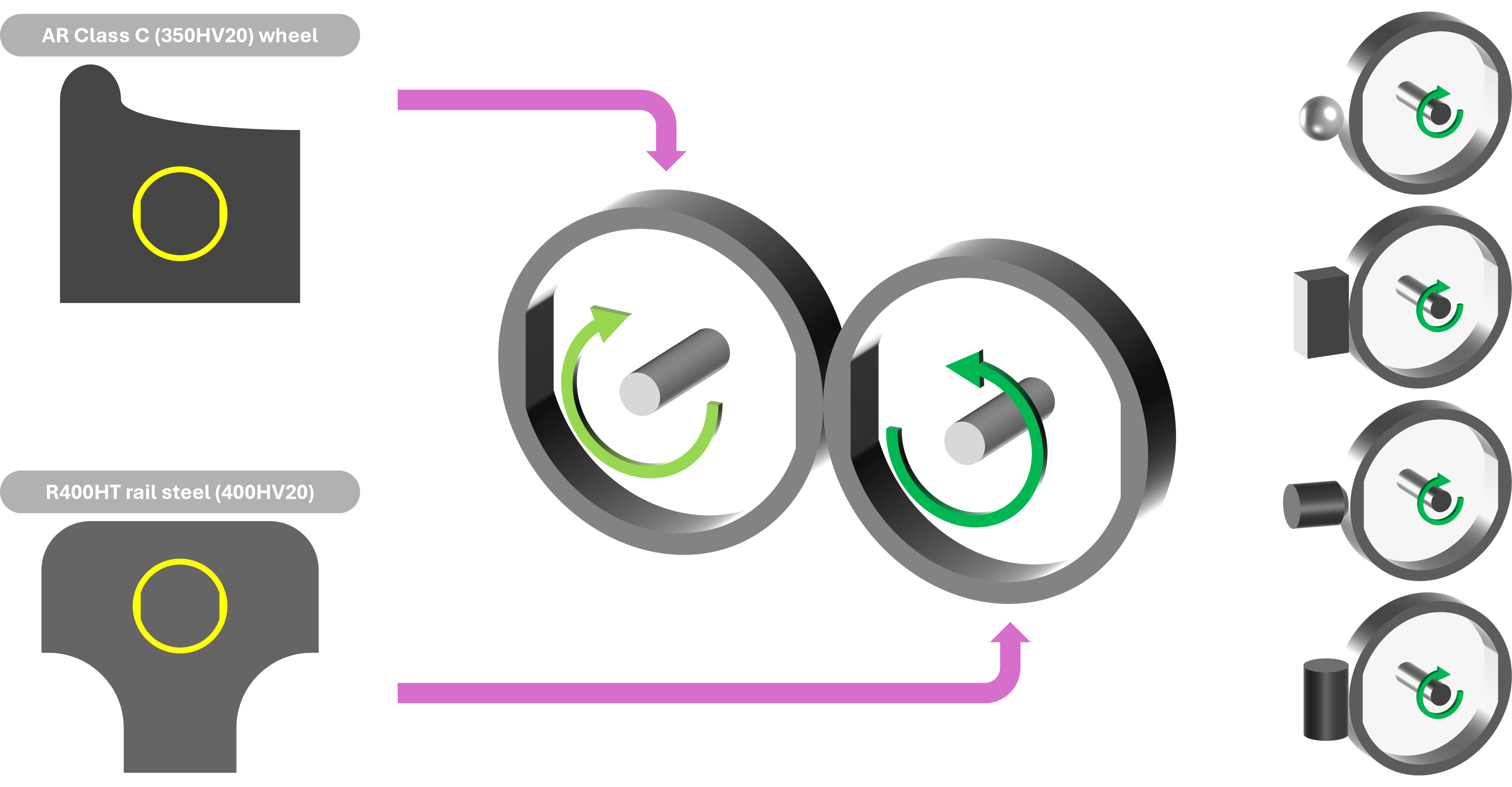
Example of test rollers carved out from real train wheel and track material (left), and schematics of alternative geometries allowed in Twin Disk.
Source: Paper from Monash University - LINK
Test Protocols
A comparison between FZG and Twin Disk reveals distinct differences in their capabilities for controlling test parameters. In FZG testing, while velocity and load can be adjusted, the relative velocity between gears and pinions teeth is determined by their geometric configuration. Conversely, the Twin Disk tribometer employs two independent motors to drive its rollers, allowing precise tuning of speeds to control the amount of rolling and sliding. This flexibility enables the Twin Disk system to dynamically change test parameters during testing, facilitating the implementation of Stribeck curves or traction curves. Such capabilities enable comprehensive characterization of lubricants across a spectrum of conditions, offering insights into their performance under varying loads and speeds. This adaptability and ability to simulate real-world operational scenarios make the Twin Disk tribometer a versatile tool for studying friction and wear behaviors, surpassing the more static nature of traditional FZG tests focused on specific gear geometries and load configurations.
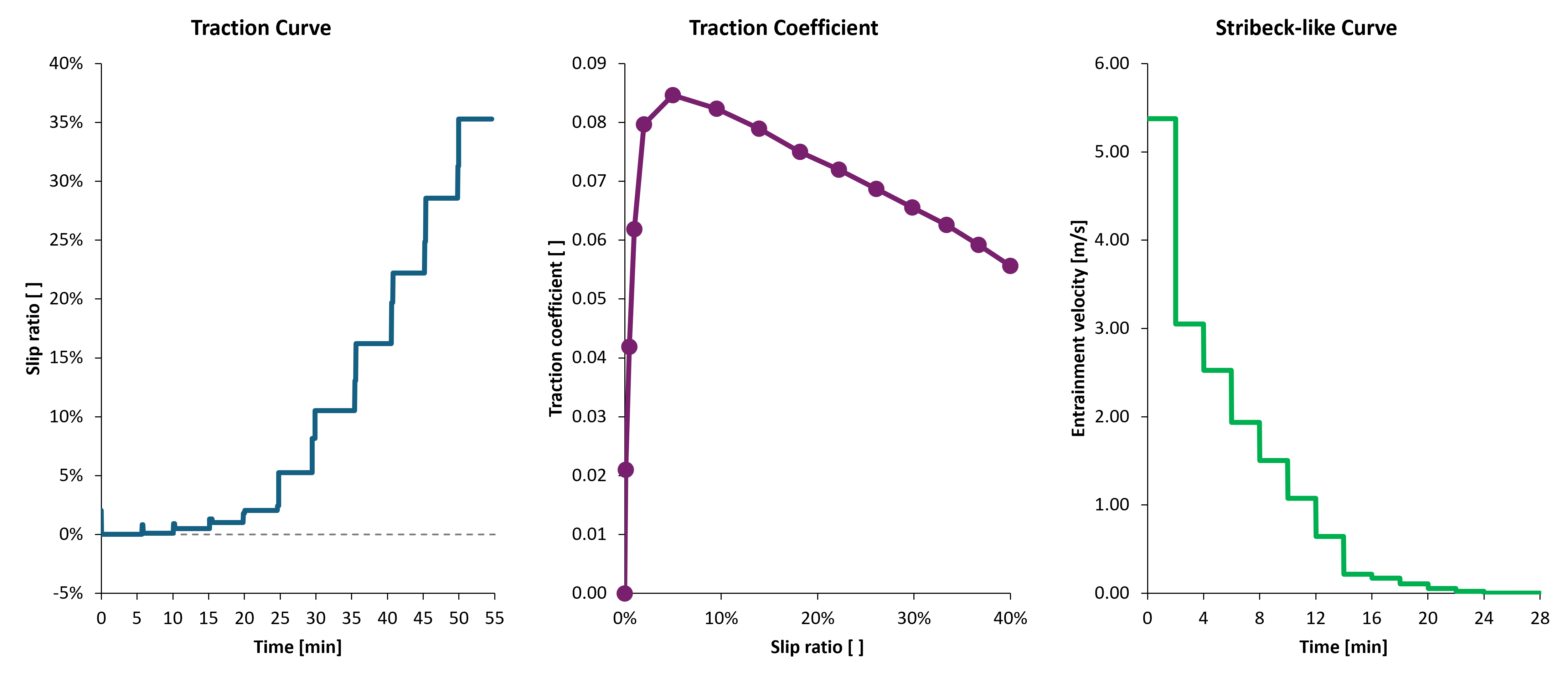
Selection of the test profiles programmable in Ducom Twin Disk. Other standard and personalized protocols available.
Full Array of Sensors
Analyzing FZG and Twin Disk, notable differences emerge in their measurement capabilities and flexibility for sensor integration. FZG primarily measures the torque required to rotate gears and the temperature of the oil bath, with limited options for adding new sensors. In contrast, the Twin Disk tribometer offers a more comprehensive range of measurements, including friction at the sliding contact, motor torque, linear wear, and vibration. These parameters are displayed in real-time on screen and recorded throughout the test, providing valuable insights, and serving as safety checks during experimentation. Analysis of these results enables the creation of characteristic curves that map the impact of different parameters on lubricated contact behavior. The Twin Disk's open architecture and straightforward roller design facilitate the integration of additional sensors, such as eddy current sensors or proximity sensors, to monitor roller surface conditions in real-time and track deterioration over time. This enhanced measurement and monitoring capability makes the Twin Disk tribometer a versatile tool for in-depth analysis of tribological behaviors and lubricant performance under varying conditions.
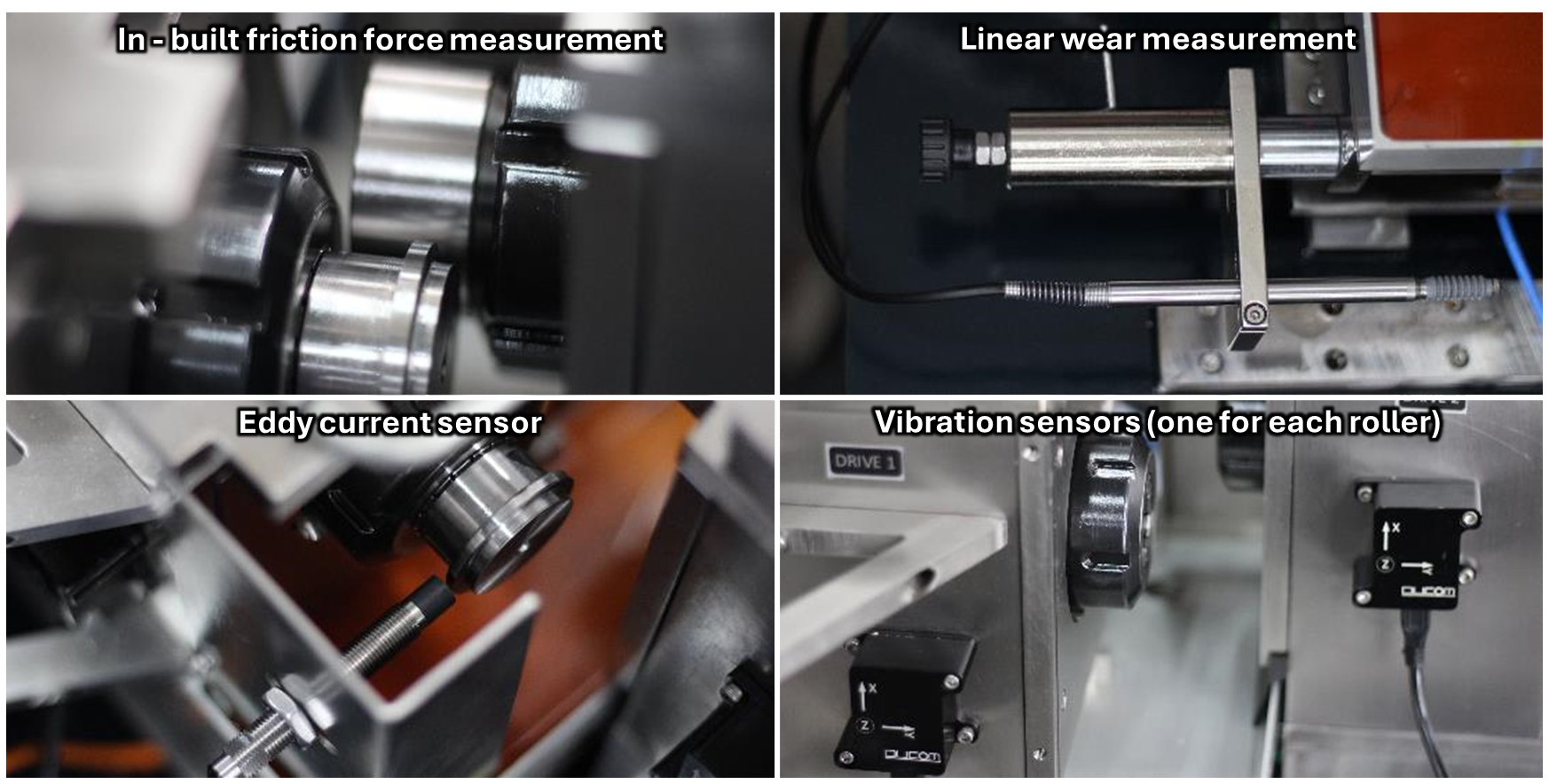
Close-up of the position of the main sensors installed in Ducom Twin Disk.
Conclusion
In conclusion, the comparison between FZG and the Twin Disk highlights the diverse capabilities and advantages of these two testing systems for evaluating material behaviors and lubricant performance. FZG excels in scuffing tests under specific load protocols, focusing on gear geometry and standard contact pressures. Twin Disk can replicate the test conditions of FZG tests in a simplified test setup, thus it represents a valid precursor to FZG tests, allowing for an overall cheaper and faster screening of lubricant formulations. Moreover, the Twin Disk tribometer offers a broader range of functionalities that extend beyond traditional FZG capabilities. With the Twin Disk, researchers benefit from its ability to simulate realistic contact conditions, achieve higher contact pressures exceeding 4 GPa, and accommodate various specimen shapes for versatile testing. The Twin Disk's programmable test profiles enable dynamic adjustments during testing, facilitating the implementation of complex interactions like Stribeck curves and traction profiles. Moreover, the Twin Disk tribometer provides comprehensive measurement capabilities with advanced sensors for friction, wear, and vibration analysis, enabling detailed characterization of lubricated contact behavior. Overall, investing in a Twin Disk tribometer promises enhanced flexibility, broader testing capabilities, and deeper insights into tribological phenomena compared to conventional FZG testing methods.
These Stories on Twin Disk
USA: +1 (847) 737-1590
India: +91 (80) 4080-5555
Netherlands: +31 (85) 065 74 10